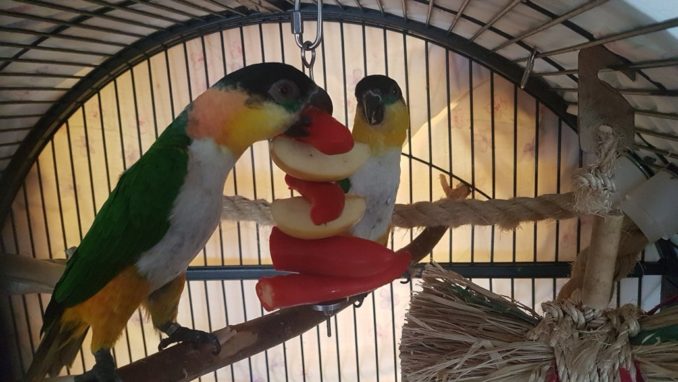
In the comments which nobody reads I often post photos of my parrots. In some photos I’ve posted they’re eating chillies. Some people have asked why I feed my birds hot chillies every day and how the birds can eat them.
Evolution my dear puffin, evolution.
The chemical produced in chillies which makes them “hot” is capsaicin; or to give it a slightly longer name 8-methyl-N-vanillyl-6-nonenamide. In mammals capsaicin triggers the transient receptor potential cation channel subfamily V member 1 (TRPV1). This is a protein encoded by the TRPV1 gene and its function is the detection and regulation of body temperature. You eat a “hot” chilli, the capsaicin triggers your TRPV1 receptor and your brain registers it as “hot”.
The TRPV1 receptor in birds is not triggered by capsaicin.
Psittaciformes (the Order of animals containing parrots) seem to especially enjoy eating chilli. Bird vision is quite a fascinating subject and their eyes are far more advanced and capable than our eyes. Among many enhancements and superior features over our own eyes, birds can see well into the ultraviolet wavelengths which are invisible to us. In fact birds’ visible spectrum is about 20% greater than ours. They can see colours we can’t even imagine. This is how birds can recognise ripe fruit, the colour stands out to them. It’s believed the red colour of wild chillies is like a big flashing neon sign to birds saying “eat me!”.
So birds evolved to eat chillies, right?
Actually no, a popular theory is it happened the other way round. Chillies evolved to be eaten by birds.
It’s been shown the germination rate of chilli seeds is adversely affected by passage through the mammalian gastrointestinal tract. Passage through the gastrointestinal tract of a bird has no effect on the germination rate. Birds are a far more effective distributor of chilli seeds than mammals, and it’s postulated this is the evolutionary reason why chillies contain capsaicin. It deters mammals (and insects too) but has no deterrent effect on birds.
Chilli is also an excellent food for birds:
- It’s rich in antioxidants
- Red chilli contains lots of Vitamin A which is required for the growth of healthy plumage
- Capsaicin supports the bird’s immune system
- Capsaicin helps control fungal growth in the bird’s crop and can prevent crop infections
And that is why I feed my birds “hot” chillies every day… along with quite a wide variety of other fresh fruit and veg.
There is however, one slight problem. If you’ve read the previous article I wrote about my birds and how I came by them you’ll remember I re-homed them when they were two years old. The previous owner and his girlfriend had taught them to “kiss”. They will quite happily march up your arm onto your shoulder, lean across and touch their beak to your lips whilst making a kissing noise. I think they’ve learned it as a social bonding behaviour and it’s something they regularly do. It doesn’t bother me except when they’ve been chomping their way through chillies and then decide to plant a big parrot kiss on my lips. My TRPV1 receptor *does* respond to capsaicin.
© Æthelberht 2018
Audio file



